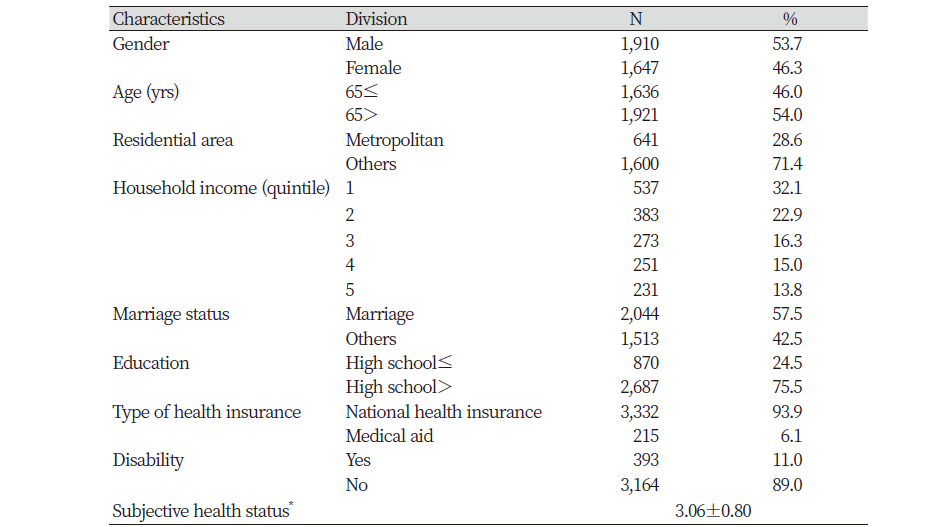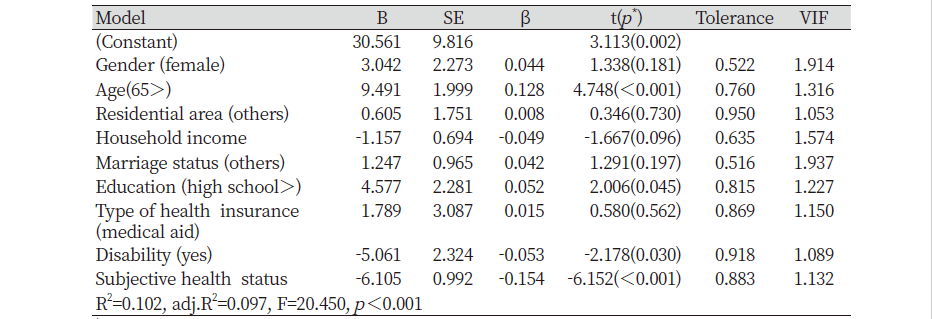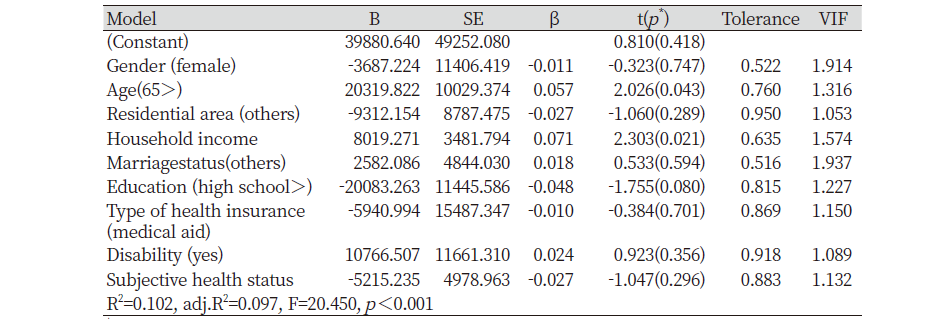Introduction
The aging population, the development of medical technology, and the improvement of living standards have led to a shift in the types of diseases from acute infectious diseases to chronic degenerative diseases. According to the 2018 statistics on the major causes of death, 7 out of the top 10 items were related to chronic diseases and comprise 80.8% of all deaths [1].
According to the 2018 Health Insurance Statistics co-published by the National Health Insurance Service and the Health Insurance Review and Assessment Service, the number of days of hospital visits, medical care benefits, and coverage all increased compared to the previous year. Among all patients, the medical costs for patients with chronic diseases increased and the amount of medical care due to high blood pressure and diabetes was greatest. Therefore, the health and medical resources used to treat chronic diseases comprise a substantial proportion of all health and medical resources [2].
Moreover, systemic diseases such as high blood pressure and diabetes are risk factors for periodontal diseases [3]. Thus, the management of these chronic diseases is also recognized as important in dental care. Dental services have a lower coverage rate than other medical services; thus, there is an active demand for the expansion of coverage [4]. According to the 2018 report on the coverage by ranking of multiple outpatient diseases by the Health Insurance Review and Assessment Service, gingivitis and periodontal diseases ranked second, and dental caries ranked sixth [2]. The coverage rate of dental care, in which non-covered care is common, is 21.7% for dental hospitals and 40.3% for dental clinics. This is still lower than the coverage rate of 62.0% across medical institutions, and thus posing a burden of high medical expenditure to the recipients of dental care [5].
In conclusion, the rapidly increasing medical expenditures in Korea are not as high as that of OECD countries, but there are demands for national policies to continuously expansion offinances in preparation of the mounting cost burden on the national economy [6]. Policies to resolve medical expenditures due to chronic diseases and dental disease are necessary.
National data on dental utilization are continuously being collected through various national health surveys, such as the National Health and Nutrition Survey, the Youth Health Online Survey, the Community Health Survey, and the National Oral Health Survey. However, in these surveys, items on dental utilization are mainly limited to the rate of dental utilization and its related indicators. Thus, there are clear limitations in identifying the characteristics of dental utilization [7]. Related in-depth research is very limited, including research on the reasons for the rate of untreated dental care and their related factors [8,9] and research on dental utilization [10,11].
Many studies have investigated the medical utilization of patients with chronic diseases. For instance, in their study, Shin and Lee [12] reported that the factors that affect medical utilization are as follows: residential area, education, type of health insurance, and income level. Kim [13] claimed that age, marriage status, education, type of health insurance, private health insurance, and economic activities affect medical expenditures.
However, research on the dental utilization of patients with chronic diseases is insufficient, and some studies have reported that high uninsured medical expenditure in dental care has a negative impact on dental utilization [11].
Therefore, there has not been sufficient empirical research on dental utilization to date. Thus, identifying the dental utilization of patients with chronic diseases may help provide basic data to resolve the inequality gap of dental utilization of patients with chronic diseases.
The National Health Panel in Korea has, since 2010, been investigating uninsured medical expenses. As representative statistics regarding indicators of health and medical service utilization and associated expenditures and resources by country, province, and city, these data include health and medical service utilization, characteristics and patterns of medical expenditure, factors that affect medical utilization and expenditure, and indicators for the establishment and assessment of health and medical policies [14].
Therefore, this study examines the dental utilization and expenditure of patients with chronic diseases, using the Korean Health Panel data [14], which have the necessary characteristics to analyze actual medical expenditures, including uninsured medical expenses that could not be identified in other panel data.
Methods
1. Subjects
This study used the most recent annual data of 2016 from the Korean National Health Panel, which is a household survey conducted nationally every year under the Korea Institute for Health and Social Affairs and the National Health Insurance Service (IRB No. 2019-02). A probability proportionate two-stage stratified cluster sampling was the sampling method. The sampling framework used 90% of the data from the 2005 household survey. For stratified variables, regions (16 cities and provinces) as well as two of towns/townships/neighborhoods were used. Out of 18, 130 household members who participated in the 2016 survey, 3,557 participants who have chronic diseases were selected as subjects of this study.
2. Research instrument and contents
The independent variables entered to identify dental utilization and expenditure of patients with chronic diseases were as follows: gender, age, residential area, household income, marriage status, education, type of health insurance, disability, private health insurance, and economic activity. Age was categorized into either 65 years or older, or younger than 65 years. Residential area was categorized into either metropolitan or others. Household income was categorized into quintile. Marriage status was categorized into either marriage or others. Education was categorized into high school completion or beyond, or below high school completion. Type of health insurance was categorized into national health insurance or medical aid. Disability was categorized into yes or no. Subjective health status was categorized on a likert-type scale (5 is very healthy; 1 is very unhealthy).
Methods of measuring medical utilization include measuring the frequency or duration of medical services provided to patients and measuring the costs of each service [15]. In reference to this, the dependent variables of this study were the total number of visits to dental institutions and the total costs of outpatient dental care over one year.
3. Statistical analysis
Using SPSS Windows version 23.0 (SPSS Inc. IL, USA), sociodemographic characteristics were analyzed with frequency, and the factors that affect dental utilization and expenditure were analyzed with a multiple regression analysis that is put into significant variables. The level of statistical significance was 0.05.
Results
1. General characteristics
The general characteristics of research subjects showed that 1,910 subjects (53.7%) were male and 46.0% were 65 years old or older. 28.6% of subjects lived in the metropolitan area. For household income, 32.1% were in the first quintile and 22.9% were in the second quintile. 57.5% of subjects were married and 24.5% completed high school or beyond. 93.9% of subjects had national health insurance for their type of health insurance, and 11.0% of subjects had disabilities <Table 1>.
2. Amount of dental use and expenditures
The mean dental utilization of research subjects was 38.5 times. The person with the lowest amount of dental use visited once a dental institution at all in a year. The person with the highest amount of dental use visited a dental institution 361 times in a year. The mean dental expenditure of research subjects was 46,796 Korean Won. Although there was a person with no dental expenditure at all, the person with the highest dental expenditure in a year spent 6,900,000 Korean Won <Table 2>.
3. Factors affecting the amount of dental use
Examining the factors that affect the amount of dental use shows that age (β=0.128, p<0.001) and education (β=0.052, p<0.05) have significant positive effects. Disability (β=-0.053, p<0.05) and subjective health status (β=-0.154, p<0.001) had significant negative effects. In other words, the amount of dental use was higher for those who are under 65 years old and have less than high school completion, and the amount of dental use was relatively lower for those who have disabilities and had a better subjective health status <Table 3>.
4. Factors affecting dental expenditures
Examining the factors that affect dental expenditures shows that age (β=0.057, p<0.05) and household income (β=0.071, p<0.05) have significant positive effects. In other words, dental expenditure was higher for those who were younger than 65 years old and those with higher household income <Table 4>.
Discussion
Although the Korean health insurance system has made many improvements in a short period of time, there is continued demand for improvements to increase the health of citizens and fair accessibility, compared to approximately 71% of all medical care services used through strategic approaches to care for the chronic diseases that citizens may have in the USA [16,17].
Thus, the present research is a cross-sectional study that attempts to provide basic data using the Korean Health Panel data to resolve the inequality gap in dental utilization among patients with chronic diseases. It does this by identifying the factors that affect dental utilization and expenditures of patients with chronic diseases.
The results of this study show that age, education, disability, and subjective health status affected the amount of dental use, while age and household income affected dental expenditures. In the case of age, Jeon and Kahng [18] have reported that old age is associated with increased medical utilization because of the decrease in physical functioning and increase in motor and functional disabilities [18,19]. However, the current study shows conflicting results, and that subjects who are younger than 65 years old have increased amount of dental use and medical expenditures. This may be because dental services incur high medical expenditures due to the insured costs from low health insurance coverage rates [20], which along with household income, has an impact.
As reported by Kim and Huh [21], the presence of disabilities was found to be a factor that affects dental expenditures. In line with the research by Hur and Kwon [20], subjective health status was found to have a significant effect on the amount of dental use. Since the need for medical service decreases with increasing perception of subjective health [22], the amount of dental use was found to be relatively lower.
For education level, Hur and Kwon [19] found that decreased education was associated with increased medical utilization. In the same vein, the current study also found that the amount of dental use was higher for subjects with an education level below high school completion. Research by Min [23] found that higher education is associated with more active health-promoting activities and maintaining healthy lifestyles through behavior; thus resulting in reduced medical utilization, and which supports the results of the present study. In contrast, Rogowski and colleagues [24] found that medical utilization decreases with lower education levels.
In terms of gender, although it is known that women have higher medical expenditures compared to men [25], there was no significant effect of gender in this study. Furthermore, a previous study on dental utilization [26] has reported that those who are insured by private insurance have a higher probability of using dental institutions. However, this variable was not considered in this study. Thus, in a follow-up study, various comprehensive variables not included in the present study should be considered for an in-depth analysis on the factors that affect dental utilization.
This study examined the dental utilization and expenditures of patients with chronic diseases, as mentioned earlier. Increased medical costs and insured medical expenses regarding the dental costs of patients with chronic diseases is a double-burden on these patients. It is anticipated that the results [1] of this study may inform the policies implemented by the government to resolve this issue. Also, to resolve the inequality gap in dental utilization among patients with chronic diseases, they receive help from their community.
Further, this study is significant because it identified the dental utilization and expenditures of patients with chronic diseases and the factors that affect dental expenditures. Limitations include the fact that a direct comparison with previous studies is limited because only some of the previous studies on dental utilization [7,26,27] have been on the dental utilization of patients with chronic diseases. Furthermore, results only considered direct effects and did not consider the indirect effects of other variables on medical utilization. It is suggested that future research will focus on whether independent variables have indirect effects on medical utilization.
Conclusions
Using the annual data from the 2016 Korean Health Panel, this study identified the dental utilization and expenditures of 3,557 patients with chronic diseases, as well as factors that affect dental utilization and expenditures, to provide basic data and resolve the inequality gap in dental utilization.
1. The frequency of dental utilization in patients with chronic diseases was high for subjects who were younger than 65 years old, and those whose education level was below high school completion. The frequency of dental utilization was relatively lower for subjects without disabilities, and those with better subjective health status.
2. The dental expenditure of patients with chronic diseases was higher in subjects who were younger than 65 years old, and those with greater household income.
The above findings suggest the need for a plan that controls dental utilization by efficiently managing chronic diseases, and a policy-based plan that supplements the uninsured medical expenses of dental care.






